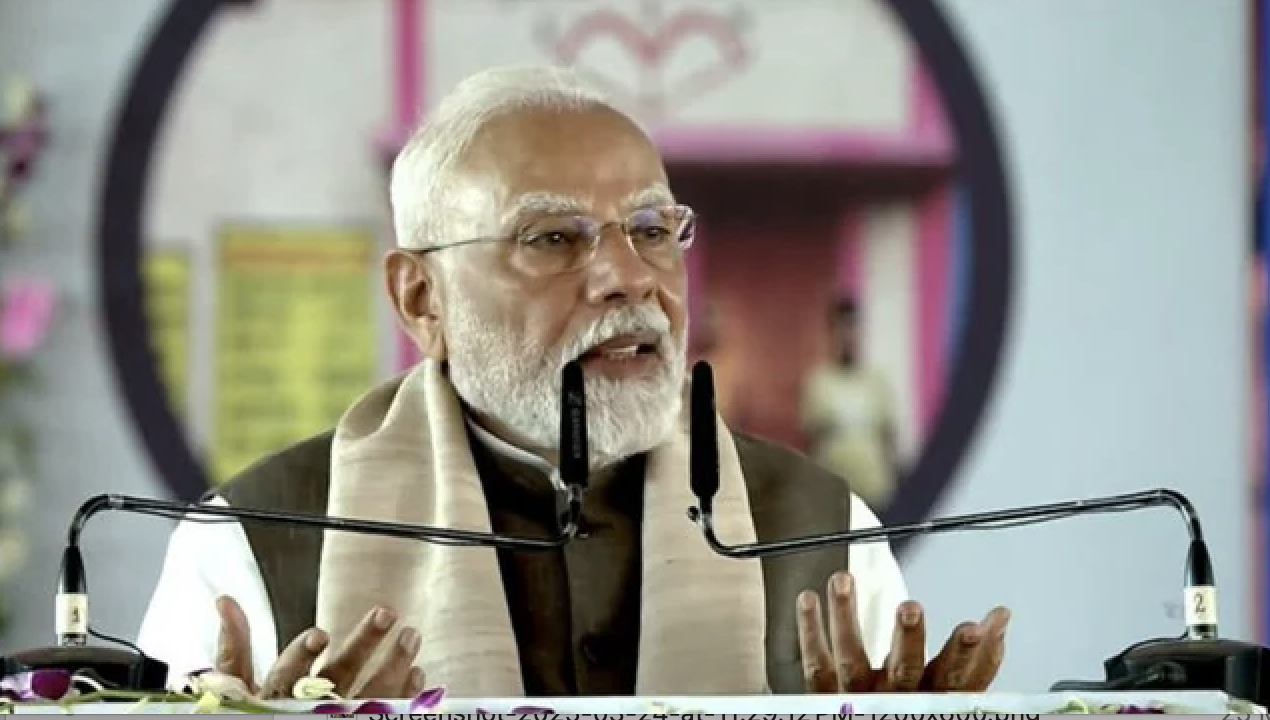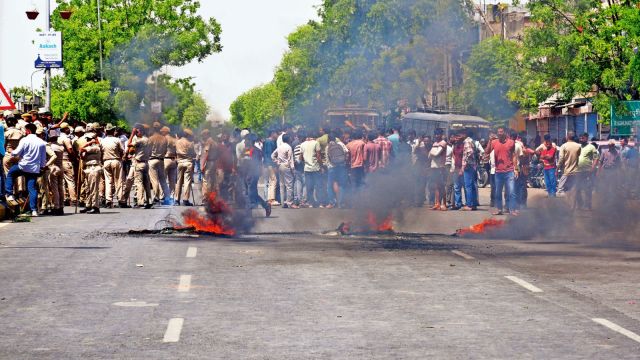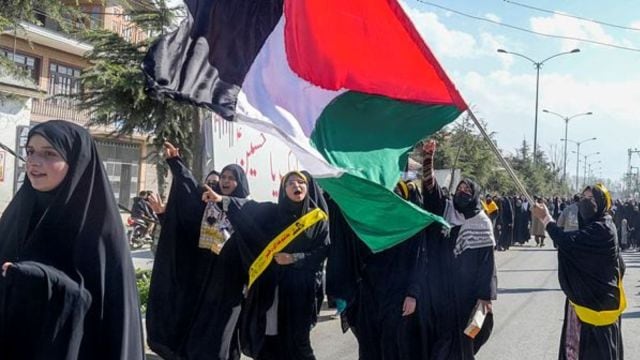No other fascist organization in the present world can beat Rashtriya Swayamsevak Sangh (RSS) in demagogy, hypocrisy and double-speak. George Orwell’s term doublespeak would be an understatement in the case of RSS.
The latest proof of this nasty character was provided by the Union Home Minister Amit Shah, de facto PM and a senior RSS leader in the Lok Sabha (akin to the House of Commons in England) on December 9, 2019. While introducing the Citizenship (Amendment) Bill, 2019 which is not only against democratic-secular Indian Constitution but also violates all humanitarian principles; this Hindutva zealot justified the need for such a law by referring to the Partition of India in 1947. He told the law-makers:
“You want to know why this bill is necessary. If the Congress had not divided this country on the basis of religion, there would be no need to bring in this bill. It was the Congress that divided the country on religious lines, not us.”
It was unashamed bulldozing of history with the aim to hide the identity of the real culprits who dissected a nation causing unimaginable bloodshed, violence and destruction. When Amit Shah claims that “it was the Congress that divided the country on religious lines, not us,” it is not due to ignorance or outcome of his illiteracy. It was Goebbels speaking through Amit Shah; shout a lie multiple times so that it becomes a truth!
Let us compare the above claim of Amit Shah with the contemporary documents available in the archives of Hindutva organizations like RSS and Hindu Mahasabha led by VD Savarkar.
Hindu Nationalists Revered by RSS Propounded Two-Nation Theory
Bhai Parmanand
It was Bhai Parmanand, a Hindu nationalist, hero for RSS (his son was appointed Governor by RSS/BJP governments) who declared in the beginning of the twentieth century that followers of Hinduism and Islam in India were two different nations because Muslims followed a religion which originated in Arab lands. Parmanand specialized in writing popular literature in Urdu in which the main emphasis would be on Hindus being true sons of India and Muslims as outsiders. [ix]
He as early as 1908–9, called for the total exchange of Hindu and Muslim populations in two specific areas. According to his plan, elaborated in his autobiography,
“The territory beyond Sind should be united with Afghanistan and the North-West Frontier Province into a great Musalman kingdom. The Hindus of the region should come away, while at the same time Mussalman in the rest of India should go and settle in this territory.”
[Parmanand, Bhai, The Story of My Life, S. Chand, Delhi, 1982, p. 36]
Moonje
Dr. B. S. Moonje, a close confidant of the RSS founder, Dr. Hedgewar and friend of Mussolini was another Hindu nationalist who carried forward the flag of Hindu Separatism long before Muslim League’s Pakistan resolution of March 1940. While addressing the third session of the Oudh Hindu Mahasabha in 1923, he declared,
“Just as England belongs to the English, France to the French, and Germany to the Germans, India belongs to the Hindus. If Hindus get organized, they can humble the English and their stooges, the Muslims…The Hindus henceforth create their own world which will prosper through shuddhi [literally meaning purification, the term was used for conversion of Muslims and Christians to Hinduism] and sangathan [organization].”[Cited in Dhanki, J. S., Lala Lajpat Rai and Indian Nationalism, S Publications, Jullundur, 1990, p. 378.]
It was sheer semi-illiteracy of Moonje that he presented England, France and Germany as justification for India for Hindus. The English, the French and the German identities had nothing to do with religious identities; these were secular identities of the people living in those countries.
‘Veer’ Savarkar
All such ideas of declaring India as a Hindu nation and excluding Muslims and Christians from it were further crystallized by Vinayak Damodar Savarkar in his controversial book Hindutva as early as 1923. Interestingly, he was allowed to write this polarizing book despite being in the British jail. According to his definition of the Hindu nation, Muslims and Christians remained out of this nationhood because they did not assimilate into Hindu cultural heritage or adopt Hindu religion. Savarkar decreed:
“Christians and Mohamedan [sic] communities, who were but very recently Hindus and in majority of cases had been at least in their first generation most willing denizens of their new fold, claim though they might a common fatherland, and an almost pure Hindu blood and parentage with us cannot be recognized as Hindus; as since their adoption of the new cult they had ceased to own Hindu Sanskriti [culture] as a whole. They belong, or feel that they belong, to a cultural unit altogether different from the Hindu one. Their heroes and their hero-worship their fairs and their festivals, their ideals and their outlook on-life, have now ceased to be common with ours.”[Maratha [V. D. Savarkar], Hindutva, VV Kelkar, Nagpur, 1923, p. 88.]
Savarkar, the originator of the politics of Hindutva, later developed the most elaborate Two-nation theory. The fact should not be missed that Muslim League passed its Pakistan resolution in 1940 only but Savarkar, the great philosopher and guide of RSS, propagated the Two-nation theory long before it. While delivering the presidential address to the 19th session Hindu Mahasabha at Ahmedabad in 1937, Savarkar declared unequivocally,
“As it is, there are two antagonistic nations living side by side in India. Several infantile politicians commit the serious mistake in supposing that India is already welded into a harmonious nation, or that it could be welded thus for the mere wish to do so. These our well-meaning but unthinking friends take their dreams for realities. That is why they are impatient of communal tangles and attribute them to communal organizations…Let us bravely face unpleasant facts as they are. India cannot be assumed today to be a Unitarian and homogenous nation, but on the contrary there are two nations in the main: the Hindus and the Moslems, in India.”[Savarkar, Samagar Savarkar Wangmaya (Collected Works of Savarkar), vol. 6, Hindu Mahasabha, Poona, 1963, p. 296.]
Guru Golwalkar
The RSS, following into the footsteps of Savarkar, rejected out rightly the idea that Hindus and Muslims together constituted a nation. The most prominent ideologue of the RSS, Golwalkar in his 1939 book We or Our Nationhood Defined decreed:
“Hindusthan, the land of the Hindus, lives and should live the Hindu Nation…Consequently only those movements are truly ‘National’ as aim at rebuilding, re-vitalizing and emancipating from its present stupor, the Hindu Notion”.[MS Golwalkar, We or Our Nationhood Defined, Bharat Publication, Nagpur, 1939, p. 43]
He went to the extent of declaring that all those who did not believe in establishing the Hindu nation
“are either traitors and enemies to the National cause, or, to take a charitable view, idiots”. [MS Golwalkar, We or Our Nationhood Defined, Bharat Publication, Nagpur, 1939, p. 44.]
Golwalkar like other RSS leaders was a great fan of Hitler and Mussolini. Glorifying the genocide of Jews by Nazis he wrote:
“German Race pride has now become the topic of the day. To keep up the purity of the Race and its culture, Germany shocked the world by her purging the country of the Semitic Races—the Jews. Race pride at its highest has been manifested here. Germany has also shown how well-nigh impossible it is for Races and cultures, having differences going to the root, to be assimilated into one united whole, a good lesson for us in Hindusthan to learn and profit by.” [Italicized for emphasis][M.S. Golwalkar, We Or Our Nationhood Defined, Bharat Publications, Nagpur, 1939, p. 35.]
The English organ of the RSS, Organiser, on the very eve of Independence (August 14, 1947 when Golwalkar was RSS chief) editorially chalked out its concept of nation in the following words:
“Let us no longer allow ourselves to be influenced by false notions of nationhood. Much of the mental confusion and the present and future troubles can be removed by the ready recognition of the simple fact that in Hindusthan only the Hindus form the nation and the national structure must be built on that safe and sound foundation…the nation itself must be built up of Hindus, on Hindu traditions, culture, ideas and aspirations.”
Dr. B. R. Ambedkar, a keen researcher of the communal politics in pre-independence India, while underlying the affinity and camaraderie between Hindu Mahasabha and Muslim League on the issue of the Two-nation theory wrote:
“Strange it may appear, Mr. Savarkar and Mr. Jinnah instead of being opposed to each other on the one nation versus two nations issue are in complete agreement about it. Both agree, not only agree but insist that there are two nations in India—one the Muslim nation and the other Hindu nation.”[B. R. Ambedkar, Pakistan or the Partition of India, Govt. of Maharashtra, Bombay, 1990 [Reprint of 1940 edition], p. 142.]
Ambedkar agonized by the evil designs of Savarkar regarding the Two-nation theory and Hindutva rhetoric over it, wrote, as early as 1940, that,
“Hindu nation will be enabled to occupy a predominant position that is due to it and the Muslim nation made to live in the position of subordinate co-operation with the Hindu nation”.[Ibid, 143.]
Hindu Mahasabha led by Savarkar ran coalition governments with Muslim League
Hindutva zealots like Amit Shah want the nation to forget that Hindu Mahasabha led by Savarkar entered into alliances with the Muslim League in order to break the united freedom struggle, specially, the 1942 Quit India Movement against the British rulers. While delivering Presidential address to the 24th session of Hindu Mahasabha at Cawnpore (Kanpur) in 1942, he defended hobnobbing with the Muslim League in the following words,
“In practical politics also the Mahasabha knows that we must advance through reasonable compromises. Witness the fact that only recently in Sind, the Sind-Hindu-Sabha on invitation had taken the responsibility of joining hands with the League itself in running coalition Government. The case of Bengal is well known. Wild Leaguers whom even the Congress with all its submissiveness could not placate grew quite reasonably compromising and socialable as soon as they came in contact with the Hindu Mahasabha and the Coalition Government, under the premiership of Mr. Fazlul Huq and the able lead of our esteemed Mahasabha leader Dr. Syama Prasad Mookerji, functioned successfully for a year or so to the benefit of both the communities. Moreover further events also proved demonstratively that the Hindu Mahasabhaits endeavoured to capture the centres of political power only in the public interests and not for the leaves and fishes of the office.”[Samagar Savarkar Wangmaya (Collected Works of Savarkar), Hindu Mahasabha, Poona, 1963, pp. 479-480.]
Hindu Mahasabha and Muslim League also formed a coalition government in NWFP also.
Hindu Mahasabha Led By Savarkar Organized Recruitment Camps for British Army against INA
As if it was not enough, Savarkar with the concurrence of RSS joined hands with the British masters in defeating Netaji Subhash Chander Bose’s attempts to liberate India militarily. Savarkar gave call for ‘Responsive co-operation’ with the British in which Hindu Mahasabha organized military recruitment camps for enlisting Hindus in the British army in order to defeat attacks by Netaji’s Azad Hind Fauj (INA).
[VD Savarkar, Samagra Savarkar Wangmaya: Hindu Rashtra Darshan, vol. 6, Maharashtra Prantik Hindu Sabha, Poona, p. 460.]
According to Rammanohar Lohia who witnessed the Partition, the Hindutva organizations through their high-pitch anti-Muslim propaganda prepared ground for helping the Muslim League to gain popularity among the Muslims as saviour of the community. The Hindu communalist who shouted loudest for Akand or united Bharat,
“helped Britain and the Muslim League partition the country…They did nothing whatever, to bring the Muslim close to the Hindu within a single nation. They did almost everything to estrange them from each other. Such estrangement is the root cause of partition.”[Lohia, Rammanohar, Guilty Men of India’s Partition, BR Publishing, Delhi, 2012, p. 2.]






